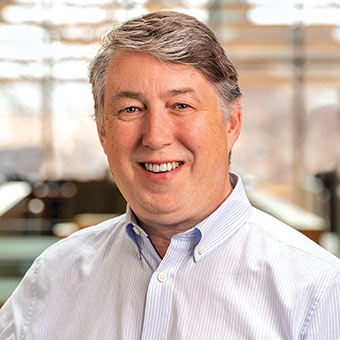‘We Need To Stop Generating Hazardous Substances’
By David Levin

Paul Anastas, GSAS MA’87, PhD’90
Photo Credit: Mara Lavitt
In April, the U.S. Environmental Protection Agency set regulations that limit the amount of certain PFAS chemicals — toxic substances known as “forever chemicals,” which persist in the ground for decades — in drinking water nationwide.
Though it’s a welcome ruling, says Paul Anastas, GSAS MA’87, PhD’90, manufacturers should have, from the start, designed chemicals that are benign to humans and the environment. Since the early 1990s, Anastas has worked to achieve this goal, first at the EPA and, since 2007, as director of Yale University’s Center for Green Chemistry and Green Engineering. His efforts to prevent chemical pollution and toxicity have earned him the moniker “the father of green chemistry.”
Here, Anastas, who is the co-author of “First Do No Harm: A Chemist’s Guide to Molecular Design for Reduced Hazard” (Jenny Stanford Publishing, 2023), talks about his work.
What makes green chemistry different?
Chemistry is the basis of everything we see, touch, and feel. It’s the basis of our society and our economy. Green chemistry uses our existing skills and knowledge to create chemicals that have the performance, functionality, and convenience of existing products yet avoid the waste, toxicity, and environmental degradation that have marked the past 200 years.
What inspired you to develop green chemistry principles?
At Brandeis, I was researching synthetic organic chemistry, focusing on making anticancer drugs. I had a postdoc job lined up at Harvard Medical School‚ but, for personal reasons, I decided I just couldn’t do it. Instead of making molecules to treat or cure cancer, I wanted to go right to the source — to make molecules in a way that would never cause cancer or toxic effects in the first place. So I joined the EPA in 1989, and two years later I launched the agency’s green chemistry program. It was a move my wonderful Brandeis professor and academic adviser, Bob Stevenson, thought would ruin my career, but I had to do it.
Where is green chemistry being used?
Green chemistry is already being practiced by companies in India, China, Australia, South America, Europe, and extraordinary. I co-founded a company called P2 Science, which uses green chemistry principles to manufacture ingredients for personal-care and cleaning products used across the U.S. and Europe. There’s another one called Air Company, which uses carbon dioxide to make tons of different products, from luxury vodka to sustainable aviation fuel — the end result is identical to regular aviation fuel on a molecular level, but it’s made without petroleum, so it’s carbon neutral. Its biggest customers so far are the U.S. Air Force and NASA. It’s no longer a question of can we do these things sustainably with green chemistry but will we?
Can green chemistry help clean up decades-old pollutants like PFAS?
Green chemistry can definitely help with environmental remediation, because most of our cleanup processes are themselves chemical in nature. But sometimes, even with the best intentions, these processes just shift pollutants around. When you extract toxic solids from soil, that can create problems with groundwater. In cleaning up the water, you can release pollutants into the air. This has been going on for decades. We are cranking out waste and persistent materials at an increasingly fast rate. We need to stop generating and using hazardous substances.
How will your latest book, “First Do No Harm,” contribute to that goal?
One of green chemistry’s principles is designing products so they won’t cause harm to humans or the environment. In some ways, this is the most difficult principle for chemists to adopt, because we haven’t been taught toxicology. Chemicals are the tools of our trade, but we’re not being taught which ones are toxic and why. That’s insane, right? Green-chemistry design techniques should be required reading for first-year chemistry students. Creating chemicals that are not harmful to us or our environment is not some kind of radical, crazy idea — it’s a forehead slapper that should be self-evident to everyone.